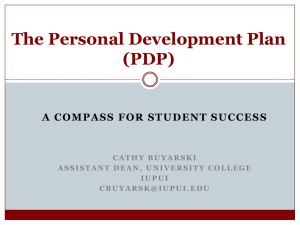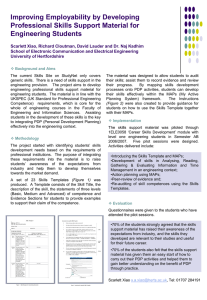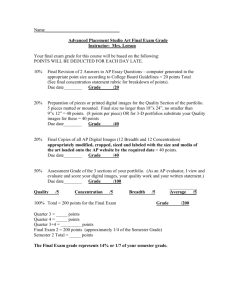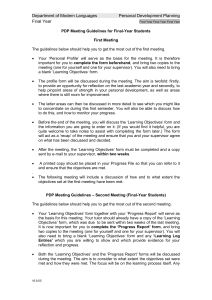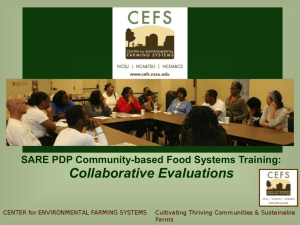PERSONAL DEVELOPMENT PLAN
advertisement
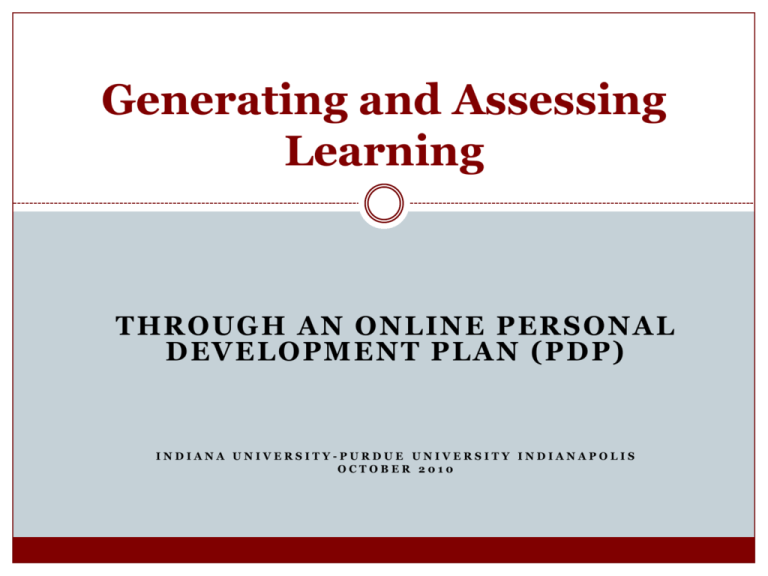
Generating and Assessing Learning TH R O UG H A N O N L I N E P ER SO N A L DE V E L O P M EN T P L A N (P DP ) INDIANA UNIVERSITY-PURDUE UNIVERSITY INDIANAPOLIS OCTOBER 2010 What is a Personal Development Plan? Personal development planning is a process which will enable first year students at IUPUI to understand, implement, and mark progress toward a degree and career goal by creating and following a personalized plan that is open to revision and reevaluation every semester in collaboration with an academic advisor or faculty member. Why are we implementing the PDP? The personal development plan is designed to foster: 1. Goal commitment (student commitment to earning a degree) 2. Academic achievement (through goal setting and planning) 3. Curricular coherence and meaning in the first-year seminar 4. Each of these goals is a way to foster student development Five Learning Outcomes for the PDP 1. Self-Assessment: Students identify success-related competencies 2. Exploration: Students research and identify realistic and informed 3. Evaluation: Students analyze their academic progress over the semester 4. Goal Setting: Students connect personal values and life purpose to the 5. Planning: Students locate programs, information, people, and academic and career goals in terms of progress toward academic and career goals motivation and inspiration behind their goals opportunities to support and reality test their goals. In the Beginning… Fall 2008 Approximately 1250 students in 52 sections completed a PDP Assessment process: focus groups, student survey, content analysis of student products Results Faculty and advisors liked the PDP but worried that it would become “busy work” and that the students wouldn’t use it moving into the future Students liked the academic planner and getting to know themselves Content was acceptable, but students didn’t present evidence or reflection at the level we had hoped Survey Results List three specific things you learned from completing a PDP: What classes I need to take in the future How to set goals for the future How to set goals for my career How to manage my time I have more goals than I thought I need campus experience I need a career goal How long my educational career will last Moving Forward Began conceptualizing the PDP as part of an electronic document that students will carry with them and update as they move through their college experience Focus on using the PDP to help students create coherence and meaning around their college experience and understand how the college experience helps develop their sense of self and shapes their future. Key Discussion Points How do we create a presentation format / process that students will find engaging and that they will “own”? What can we reasonably expect from first-year students? How can we honor student’s personal and cognitive development and build a framework that will be suitable as they learn and mature? How can we build a framework that may allow other programs to utilize the tool? Components of “ePDP” About Me Educational Goals Educational Plan Career Goals My Academic Showcase My Co-Curricular Experiences Resume Structure of ePDP and FYS Curriculum The ePDP is a presentation; it is the outcome of a semester’s worth of work But more importantly . . . ePDP is facilitated by the development of assignments and templates that support successful completion of each reflective prompt Why an electronic portfolio? Easier to manage the portfolio process Access Presentation Duplication Evaluation Storage Hypertext links allow clear connections between information presented and portfolio artifacts Motivational for students and addresses ownership issues of student-created work Creating an electronic portfolio can develop skills in using multimedia technologies (Barrett, 1997; Rogers & Williams, 2001; Wetzel & Strudler, 2006) Generating Learning About Me: Developing Identity Who am I? What factors contributed to who I am? Who do I want to become? What evidence might we see from a student who has achieved the descriptor for the section? What reflective prompts might generate that evidence? Assessing Learning: Section Rubrics Section: ABOUT ME Background Information Beginning Developing Competent Proficient Identifies elements / aspects of my personal identity Explains those elements / aspects of my identity such that someone who doesn’t know me will understand my background Gives examples of how these elements / aspects of my identity play out in my life Relates these elements/aspects of my identity to my success as a student this semester and beyond - how do or might they positively and negatively influence my success as a student? Assessing Learning: Section Rubrics Section: ABOUT ME Personal Strengths Beginning Identifies my strengths Developing Competent Explains what Gives each strength examples of means in my how each own words such strength plays that someone out in my life who doesn’t as a student know me will understand them Proficient Relates these strengths to my success as a student this semester and beyond - how does or might they contribute to my success as a student? Assessing Learning: Section Rubrics Section: ABOUT ME Lifetime Achievement Award Beginning Developing Identifies Explains attributes of these who I want attributes so to become that someone and the life who hasn’t I want to known me have lived throughout my life will understand the life I have designed Competent Proficient Gives Relates the examples of the attributes of who potential I am and what I highlights / will have accomplishaccomplished in ments of my life my life to my life in which these priorities and attributes will passions. have played out A Cyclical not Linear Process Assessment Outcomes Pedagogy Assessment in Practice Classroom practice First-Year Seminar and Intro to the Major in Psychology First-Year Seminar and Introduction to Professional Practice in Nursing About Me in Psychology Mind and Body TLC Purpose to integrate three courses: Orientation to the Psychology Major Psychology as a Biological Science Public Speaking Themed Learning Community for first-year, traditionally aged college students 3 Stages of the Assignment • Create an “About Me” section utilizing the prompts in the PDP and the added worksheet to create a Mission statement. • Do exercise in class about culture’s impact on identity and motivation. • Meet with Cree Elders and hear stories of their understanding of who they are and compare it to the in-class exercise. • Give feedback of first try at About me using rubric and formative assessment and have them utilize feedback and resubmit “About Me” section. Lessons Learned Diversity of faculty perspectives and experience Teaching and Pedagogy Is the sum greater than the parts when it comes to assessment? If so, how do we assess so as to document the “greater-ness”? References Barrett, H. (1997). Collaborative Planning for Electronic Portfolios: Asking Strategic Questions. Retrieved October 15, 2010 from http://electronicportfolios.org/portfolios/planning.html . Rogers, G. & Williams, J. (2001). Promise and Pitfalls of Electronic Portfolios: Lessons Learned from Experience. Retrieved October 15, 2010 from http://www.abet.org/Linked DocumentsUPDATE/Assessment/Promise and Pitfalls of Electronic Portfolios_2001.pdf. Wetzel, K. & Strudler, N. (2006). Costs and Benefits of Electronic Portfolios in Teacher Education: Student Voices. Journal of Computing in Teacher Education. 22(3): 69-78.
